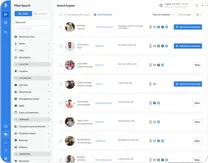
B2B prospecting isn’t just about making calls; it’s about making the right ones. This is where b2b prospecting methods come into play. They’re more than just techniques; they’re game-changers. Many businesses love them because they’re direct, effective, and smart.
When we talk about the best b2b prospecting methods to use, we’re highlighting strategies that truly work. In this guide, we’ll dive into these methods, showing you why they’re top picks and how to use them effectively.
Let’s get started!
What is B2B Prospecting?

It’s the search for potential buyers to grow your business. The main goal? Lead these prospects to buy. While it seems easy, it’s tricky in practice.
Research indicates that half of sales time is lost on ineffective prospecting. Imagine the sales boost if that time was better utilized!
How to Prepare for B2B Sales Prospecting

Before reaching out to potential B2B clients, it’s important to be well-prepared. Here are major steps to optimize your approach and maximize results.
1. The Ideal Customer Profile (ICP)
Before diving into prospecting, it’s crucial to know who you’re looking for. The ICP serves as an outline for salespeople to identify the perfect lead. It improves data accuracy on potential prospects, increasing the likelihood of sealing deals and drawing more leads in the future.
Key elements to consider in an ICP include:
- Company size: Reflecting their budget and revenue.
- Industry: Especially if your product caters to a specific niche.
- Geography: Where your company can operate.
- Legality: Legal standards your company or partners must adhere to.
2. Account Penetration
While many focus on the C-suite, it’s essential to remember that modern sales cycles involve multiple decision-makers across a company’s hierarchy.
Therefore, understanding and penetrating accounts is more than just targeting top executives. It’s about engaging with various influencers within an organization.
3. Using LinkedIn & Crunchbase for Prospecting
LinkedIn has become a pivotal platform for B2B prospecting, boasting 171 million U.S. users in 2020 and ranking as the second most preferred site among B2B marketers, just after Facebook. It offers a rich environment for networking and lead generation.
On the other hand, Crunchbase is renowned for its company-specific data, providing valuable insights that enhance prospecting efforts. For professionals seeking to leverage LinkedIn for B2B marketing, considering the LinkedIn Sales Navigator plans could offer advanced tools and analytics to refine and execute their prospecting strategies effectively.
4. Engage with Your ICP Actively
Awareness is key. Your reps should make prospects within your ICP aware of your offerings. This can be achieved through:
- Cold calling.
- Outbound emails.
- Social media engagement.
5. Pre-qualifying Leads
An ICP is a guideline, but not every potential lead will be interested. Pre-qualifying questions can help filter out unsuitable prospects. Questions to consider include:
- Is my product relevant to their industry?
- Are they showing interest in my offering?
- Do they use a competitor’s similar product?
- Can my product address their pain points?
- Has their company been impacted by economic downturns?
6. Dedicate Time for Consistent B2B Sales Prospecting
How much time does your team allocate for prospecting? Research indicates a direct link between time spent prospecting and sales success. Top performers that’s 82% dedicate at least four hours daily to this task. Consistency in prospecting, like regular gym sessions, might not be fun but yields better results over time.
11 Methods for Using in B2B Prospecting
Getting B2B right requires a mix of traditional and modern thinking. Below are the most effective B2B prospecting methods to connect with potential clients.
Cold Outreach Techniques
Though many misunderstand the cold technique, it is still considered an effective method. In fact, 6 out of 10 people buy from reaching cold emails.
Cold Emailing
A cost-effective B2B sales technique, cold emailing targets specific leads without being intrusive. It’s a subtle way to introduce your offerings without the directness of a call.
Cold Calling
Contrary to popular belief, cold calling isn’t obsolete. When aligned with your ideal customer profile (ICP), it can be impactful. According to RAIN group research, 70% of sellers talk to buyers over the phone. The primary goal isn’t immediate sales but building a rapport.
Follow-Up Emails
After an initial outreach, follow-up emails play a pivotal role in B2B sales techniques. As per the American Marketing Association, 80% of sales necessitate 5 or more follow-ups.
These emails should be personalized, value-driven, and timed appropriately to nurture the relationship without appearing pushy.
Inbound Marketing
Opposite to cold outreach, inbound marketing focuses on creating content that connects with potential clients. By offering valuable insights or solutions, your aim is to speed up the sales funnel journey or even get prospects to begin contact.
Before you dive too deeply into effective methods, explore these B2B prospecting tools that industry experts recommend.
Social Media Selling
With the rise of professional social platforms, social selling has become a prominent B2B prospecting tool. Beyond LinkedIn, platforms like Twitter and Facebook can be leveraged to establish connections. Social media fosters deeper relationships, instilling trust that simplifies the B2B sales process.
Use the Right Technology
Before diving into tools, establish your strategy. Investing in B2B prospecting tools should support your strategy, not dictate it. When the focus shifts to technology over process, it can hinder results.
However, with proper research and team input, modern tools can amplify your efforts. Some essential tech includes:
- Data and Prospecting Insights
- Sales Enablement
- Social Selling
- Auto Dialers
- Lead Management
- Meetings and Product Demos
- Lead Scoring
- Scheduling
- Sales Performance
If you’re new to B2B prospecting, starting with the best contact finding tools can make a significant difference.
Asking Questions
Did you know that asking 11 to 14 questions during a call can yield 74% better results? The NOTE method, created by Sean Burke, can guide your questioning:
- N (Need): Understand the company’s current and desired situation.
- O (Opportunity): Identify challenges hindering their goals.
- T (Team): Recognize influencers and the product’s impact.
- E (Effect): Gauge expectations from the collaboration.
Engage in Online Communities
Participate in industry-specific online forums like Reddit. These platforms house enthusiasts who discuss trends and issues. That being said, connecting online isn’t the only method; sales reps have unique strategies to generate leads swiftly.
To be effective, contribute valuable insights without overt sales pitches. Knowledge is key; ensure you’re well-versed in the topics discussed.
Network at Business Events
Business events, whether attending conferences or hosting your own, offer prime B2B prospecting methods. These gatherings allow for networking, showcasing product developments, and celebrating milestones, all while filling your sales pipeline.
Implement Sales Cadences
A sales cadence combines multiple outreach channels in a sequence. Using emails, LinkedIn messages, and cold calls in tandem increases the chances of eliciting a response from potential buyers.
Personalize Your Outreach
Cold doesn’t mean impersonal. Personalized emails, referencing mutual connections or recent company achievements, can make your outreach stand out. So, avoid generic greetings and aim for a touch of personal connection.
Get Referrals
Word of mouth remains a potent B2B prospecting method. Seeking referrals from satisfied customers not only extends your network but also brings in leads that are easier to convert, thanks to the trust already established.
Key Metrics for Measuring Prospecting Performance
B2B sales prospecting is all about understanding your performance. You can identify strengths, pinpoint areas for improvement, and refine your strategies by tracking metrics. Here’s a breakdown of four vital metrics to keep an eye on.
Prospects Count
Begin by assessing the number of prospects you’re attracting and the time taken to do so. This serves as a foundation for other metrics and ensures you’re consistently filling your sales funnel.
Activity Metrics
Consistency is key. Determine the number of activities required to engage a prospect. Thus, regularly executing a specific set of sales tasks daily, weekly, and monthly is essential to generate new leads.
Response Rate
You can measure the effectiveness of your outreach by calculating the response rate. This metric is derived by dividing the number of replies received by the total contacts made.
A higher response rate indicates successful outreach tactics, while a lower one may suggest the need for a strategy shift.
Prospect-to-SQL Ratio
Lastly, measure the conversion of prospects into sales-qualified leads (SQL). A good way to measure lead qualification efficiency is to divide the number of SQLs by the total prospects contacted. A low ratio might indicate the need to refine your lead qualification criteria.
Make Better Prospecting with Swordfish AI
Swordfish AI is transforming the B2B sales prospecting scene. Here are its five standout features that can significantly improve your outreach efforts —
1. Direct Access to Decision Makers
With Swordfish AI, you can reach key decision-makers directly with cell phone contacts. This direct access increases the likelihood of booking meetings and driving sales.
2. Unparalleled Accuracy in Data
It boasts a 33% higher cell phone number availability and 45% more accuracy than other providers. Plus, real-time line connectivity validation ensures you’re contacting active numbers.
3. Comprehensive Chrome Extension
You can effortlessly find verified contact data across platforms like LinkedIn, Twitter, and Facebook through its Chrome Extension. It’ll make prospecting seamless and efficient.
4. Advanced Prospecting Tools
Prospector feature allows you to swiftly generate targeted dialing or email lists. By using advanced filters, you can ensure accurate lead generation specific to your needs.
5. Efficient Data Enrichment
It’s File Upload feature improves your CRM by filling in missing contact details. This ensures your database is always up-to-date, optimizing your outreach efforts.
All things considered, you should check out Swordfish AI now.
Conclusion
B2B prospecting is a journey, not just a task. Throughout this guide, we’ve looked into its many sides. We’ve learned the importance of truly understanding our target audience. Platforms like LinkedIn have proven as invaluable assets for modern outreach.
Advanced tools, especially Swordfish AI, have shown potential in supercharging the prospecting process. But it’s not just about tools and platforms. Regularly measuring your performance using key metrics is essential.
It helps you refine your approach and stay aligned with our goals. As the B2B industry continues to change, staying updated and adaptable is the key. Remember, every interaction counts, and with the right strategies, success is within reach.
Frequently Asked Questions
What is the 3X3 approach to prospecting?
The 3X3 approach suggests spending three minutes to gather three relevant pieces of information about a prospect. This ensures a quick yet informed outreach, making calls more valuable.
What does intelligent prospecting mean?
Intelligent prospecting involves using advanced tools and techniques to enhance sales outreach. It refines the identification of ideal prospects and boosts the success rate of engagements.
What is a B2B target?
B2B targeting involves choosing segments that offer maximum potential for your business. Tailored marketing strategies are then developed for each selected segment.
What is a B2B cycle?
The B2B sales process has six stages: prospecting, connecting, qualifying, researching, presenting, handling objections, and closing. Specific tasks are assigned to teams at each stage to streamline the process.
How does technology aid in B2B prospecting?
Technology greatly improves B2B prospecting by automating activities like cold calling, emails, and social selling. It’s essential for marketing tasks like PPC and content creation. Sales and marketing teams rely on tools, especially in the SaaS model, like Asana and HubSpot, to make prospecting more efficient.


 View Products
View Products



